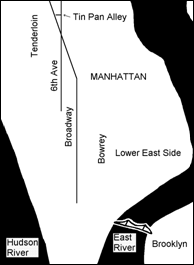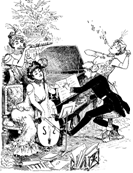Origins of Popular Music
Dominic
Vautier 1/7/2011
The year was 1892
and some hot new songs appeared. The upper classes
scoffed at the music. Just like rap
music, they
did not understand it it at all, they did not like it, and they did not care to be
associated with it. It was
seen as being directed to the lowest of society, bereft of any redeeming
or “uplifting” quality. It
was mediocre, empty of spiritual and artistic merit, composed by a bunch
of second hand hacks who had no idea of musical form, and the street
music had no socially redeeming value whatsoever. The lyrics were even worse, dealing with earthy and undignified
topics, often tasteless and moony. These
Americans who took their social position seriously
felt that members of the rising middle class, who seemed to be
particularly taken in by this music, should instead embrace the higher
standards of people with “taste and breeding.”
But the new middle class insisted on dragging this cheap and
degrading music of the lower classes up with them to a higher social
status. It was all wrong.
But people of all
social levels and religious persuasions did however, have to admit that
an industry was coming to life with all this cheap low brow music.
Suddenly everyone wanted to buy sheet music. It started
selling in very large quantities, millions of copies to be precise.
Not surprisingly, publishers suddenly started getting very rich. This phenomenon was not just happening in the cities.
The country as a whole was falling under the impelling grip of
this new music fad that was apparently designed to appeal to the lowest of
tastes.
 By
that time most of the writers of popular music tended to live in New York, occupying the beat-up and otherwise unused brick buildings along
28th Street between 5th Avenue
and Broadway in Manhattan. These buildings had been
abandoned years earlier by wealthier classes, who had migrated to open country further north.
This
area came to be known after 1909 as the “Tin Pan Alley” district.
Songwriters and musicians were drawn here because of the
proximity of publishers, the availability of cheap rent, the exposure to
people of the same trade, and a general acceptance of musicians from
the local inhabitants. And
besides there were so many rich sources of subject material close by: the
Tenderloin, with its cheap brothels and taverns; the Bowery, with its
theaters and Vaudeville houses; the Lower East side with its vast
immigrant diversity; and the
Great White Way (Broadway) with its shows and musicals.
By
that time most of the writers of popular music tended to live in New York, occupying the beat-up and otherwise unused brick buildings along
28th Street between 5th Avenue
and Broadway in Manhattan. These buildings had been
abandoned years earlier by wealthier classes, who had migrated to open country further north.
This
area came to be known after 1909 as the “Tin Pan Alley” district.
Songwriters and musicians were drawn here because of the
proximity of publishers, the availability of cheap rent, the exposure to
people of the same trade, and a general acceptance of musicians from
the local inhabitants. And
besides there were so many rich sources of subject material close by: the
Tenderloin, with its cheap brothels and taverns; the Bowery, with its
theaters and Vaudeville houses; the Lower East side with its vast
immigrant diversity; and the
Great White Way (Broadway) with its shows and musicals.
Then a Bomb
exploded.
Sources of American Popular Music
Minstrelsy
Minstrel shows began in 1844,
around the same time that Foster started publishing. Minstrelsy was a type of musical theater that followed a set
format and used a predefined set of characters. It became very popular just before the Civil War.
The great pioneer in this field was
Edwin Christy, who developed what was considered the standard format.
Minstrelsy utilized basic ideas of Greek Drama. The blackface and whiteface were masks or “persona” which
transformed an individual into something else, a stage actor. For
a more complete discussion see Minstrelsy.
Vaudeville
Vaudeville is a non-stop variety show
featuring different acts, songs, dances, burlesques, and skits. Through this type of entertainment, the customer is exposed to a
continuous array of entertainment, like going to movies in the old days
when few were concerned with start times or ending times, and came at
their own convenience.
There were jugglers, acrobats, animal
acts, skits, burlesque, singers, strong men, magicians, slapstick, and
the occasional and often pre-planned audience participation. For
more on this see Vaudeville.
Broadway
Musical Comedy in the U.S. developed
into a completely American type of musical theater that was able to
tightly integrate
music and story. For more on this see Broadway.
Other Sources
Popular music borrows from whatever
musical tradition it can find. There
was a lot to borrow from, especially in New York. Some
of the forms of music that existed had a fairly minor effect on it's
overall development but can be briefly looked at here in Minor
Sources of Popular Music.
Put it together

Here are some other links in this
article:
Origins
of Early Popular Music
Minstrelsy
Broadway
Vaudeville
Other sources
People
Growth - the First Baby Boom and it's effect
How
Dancing Helped Music
Women
and Early Music
Some
Early Songwriters
Some
Songs
The
Influence of the Piano
Recorded
Music
Sheet Music
Chronicles
1892-1900
Chronicles
1901-1915
Million
Sellers
 America
at this time was endowed with all kinds of music so why another fad?.
The older,
classical, more established music discredited any need for or
legitimacy of such an entirely new type.
After all, Extravaganzas[1]
were enjoying more popularity than ever before, and so were pantomimes[2]
and especially English Operettas. In
1878, H.M.S. Pinafore opened
to packed houses across the country and brought on a rage of American
operettas that lasted for almost 20 years. Vaudeville houses were thriving in every big city on the East
Coast. By 1892, Tony Pastor,
the king of vaudeville, had been playing to full houses for five years
solid. The revue, a
theatrical spectacle, was starting up and doing well. New musical comedies were hitting Broadway.
Burlesque shows were popular and were being presented in most
large cities. Minstrel shows were playing to packed houses. There
was an insatiable desire for entertainment. In the south, Jazz was emerging, and
St. Louis had its very own music called ragtime. America was ablaze with song.
But
prior to 1892, not much of it was truly American Popular music in the
Foster tradition. This was
to change.
America
at this time was endowed with all kinds of music so why another fad?.
The older,
classical, more established music discredited any need for or
legitimacy of such an entirely new type.
After all, Extravaganzas[1]
were enjoying more popularity than ever before, and so were pantomimes[2]
and especially English Operettas. In
1878, H.M.S. Pinafore opened
to packed houses across the country and brought on a rage of American
operettas that lasted for almost 20 years. Vaudeville houses were thriving in every big city on the East
Coast. By 1892, Tony Pastor,
the king of vaudeville, had been playing to full houses for five years
solid. The revue, a
theatrical spectacle, was starting up and doing well. New musical comedies were hitting Broadway.
Burlesque shows were popular and were being presented in most
large cities. Minstrel shows were playing to packed houses. There
was an insatiable desire for entertainment. In the south, Jazz was emerging, and
St. Louis had its very own music called ragtime. America was ablaze with song.
But
prior to 1892, not much of it was truly American Popular music in the
Foster tradition. This was
to change.
